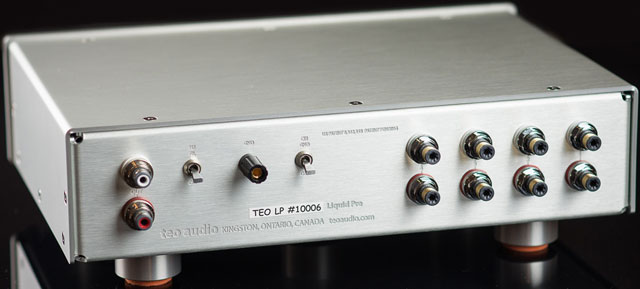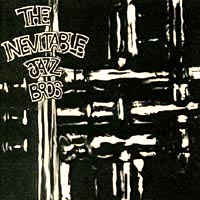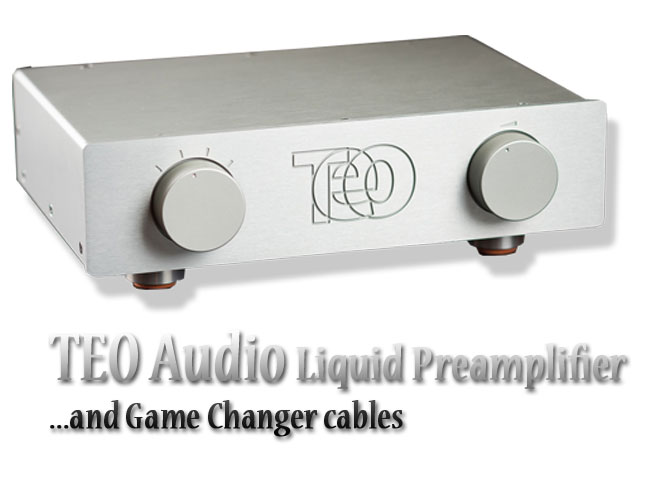TEO Audio Liquid Preamplifier
 Reading from the About page on TEO Audio’s website, TEO’s principal partners, Ken Hotte and Taras Kowalczyszyn are described as “two intellectually itinerant inveterate tinkerers” who apparently started their tinkering with new audio product designs back in the early 1990’s, refining them over the years. TEO Audio was formally launched in 2007 and their Liquid Metal audio cables and Liquid Metal passive preamplifier began production and marketing. Other innovative ideas and products are waiting in the pipeline.
Reading from the About page on TEO Audio’s website, TEO’s principal partners, Ken Hotte and Taras Kowalczyszyn are described as “two intellectually itinerant inveterate tinkerers” who apparently started their tinkering with new audio product designs back in the early 1990’s, refining them over the years. TEO Audio was formally launched in 2007 and their Liquid Metal audio cables and Liquid Metal passive preamplifier began production and marketing. Other innovative ideas and products are waiting in the pipeline.
As Taras K explained to me, the liquid metal in their audio cables is an amalgam of indium, gallium, and tin. I’m not sure how TEO came up with that seemingly odd combination of elements for their liquid metal, but apparently it works very well. It is linear and has impressive high frequency extension. Interestingly, TEO uses the same liquid cable for all their liquid cable products—there are a few different levels of liquid cables and the main audible differences are the result of using modified higher performance terminations as you move up the line.
I found their basic $499 Game Changer interconnects to be a bit forward sounding in the lower treble. The soundstaging is very wide but not as deep as some of my other cables. I did not use the Game Changers in combination with the Liquid Pre for this review because I found it too forward sounding for my speakers and I achieved a better match with my other cables. That said, the Game Changers sounded quite good in my Large Room System with my Rogue Audio Stereo 100 tube amp and Legacy Audio Focus SE speakers when I used them between my tube phono stage and the Lyngdorf DPA-1 pre/pro. Previously the phono had been a bit more laid back in the lower highs than I prefer, but the Game Changers provided a better balance to the sound that worked well in that position.
Features
First of all I would like to applaud TEO’s wonderful shipping cases in which their products are shipped. They use a sturdy plastic case with medium density foam fully encapsulating their products inside. This makes for an almost fool-proof shipping container and since the products are shipped from Ontario, Canada, a sturdy container like this is what we hope for—but don’t always get. Obviously TEO Audio values their products, and their customers.


The Liquid Pre uses a thick gauge stiff aluminum chassis that is strategically damped internally. The rotary Input Selector is very smooth in its action as is the stereo resistive ladder Volume Control. There are four pairs of Furutech gold-plated RCA input jacks and a single pair of WBT NextGen RCA outputs on the standard model. I was told that another pair of output jacks could not be easily added because it would require the addition of a transformer, which TEO frowns upon.
There are two switches on the rear panel. One lifts the ground, and the other adds a high frequency filter. Taras K explained to me that the preamp extends into extreme high frequencies and that sometimes if an amp with an extended high frequency response is used the amp can oscillate in the high frequencies. So to prevent that from occuring the high frequency filter rolls the preamp’s output at a very high frequency. With my monoblock 300B amps setting the switch either in or out the effect of the switch is hardly audible in the audio band.”
Set up
The Liquid Pre is quite simple to set up in a system as one might guess. In my Small Room Reference System, I inserted the Liquid Pre between the analog outputs of my PS Audio DirectStream DAC and my modified Dignity Audio 300B mono amps. I hooked up the supplied ground cable and left the internal ground switch in the connected position. I set the Volume low, the Input Selector to the correct input, the treble filter to On and loaded a CD into the PS Audio DirectStream Memory Player’s drawer. Then sat back and pressed “Play” on the remote.
The Listening Experience
My initial impression of the TEO Audio Liquid Pre was quite favorable. The soundstage was especially expansive in both width and depth. Bass articulation was impressive, the midrange musical and very well focused. Plus the dynamic contrasts were quite dramatic.
One interesting thing about the Liquid Pre is that it comes with some ordinary looking foam that fits inside hollows in the unit’s five feet. I left the stock blue foam pieces in the four corner feet but changed the center foot from blue to pink foam and that seemed to provide a nice overall balance to the sound. But when I used three of Mike Kelly’s Baltic Birch and cork footers on the chassis to lift the TEO off its stock feet it sounded even better. I put two of the Kelly footers to the insides of the front feet and then used a single Kelly footer at the center rear of the unit.
 After playing a few tunes, my general feeling was that the Liquid Pre is linear, extended, and natural sounding. Playing “Ballin’ the Jack” from “The Inevitable Jazz Brothers” CD (cdbaby.com/ijbros) the baritone sax on the left was lifelike, and the banjo (center) and trumpet (right) sounded fantastic all playing together. I found myself reliving the live experience. The Tiger Rag was similarly delightful with Rosano Dante’s triple-tonguing on the trumpet and some spirited banjo playing.
After playing a few tunes, my general feeling was that the Liquid Pre is linear, extended, and natural sounding. Playing “Ballin’ the Jack” from “The Inevitable Jazz Brothers” CD (cdbaby.com/ijbros) the baritone sax on the left was lifelike, and the banjo (center) and trumpet (right) sounded fantastic all playing together. I found myself reliving the live experience. The Tiger Rag was similarly delightful with Rosano Dante’s triple-tonguing on the trumpet and some spirited banjo playing.
The String Bass on Patricia Barber’s cover of Use Me from her “Companion” CD (Blue Note/Premonition 7243 5 22963 2 3) sounded very organic, distinct, and authentic, while Barber’s vocal was soulful and nuanced. Track 5, “Trash” demonstrated superb percussive effects and the poignant cymbal crashes and rim-shot strikes added a fair bit of depth and atmosphere to the soundstage. And although the organ on Barber’s rendition of “Black Magic Woman” seemed a touch thin (break-in?) the drum solo was bombastic. It was taut and the tuning on the drum heads was superbly rendered. The cymbals and high frequency percussion was explosive. It literally came out of nowhere, it was that dramatic.
 Moving to Fiona Apple’s Tidal CD (Work DK 67439) and listening to “Criminal,” the bass was deep and powerful and the soundstage depth was Huuugge! The high frequency percussion added more dimension to the mix along with the keyboard’s piano effect. And Fiona’s breathy vocal on “Slow Like Honey” was almost spooky and oozed with her sexuality—I hope I’m not in trouble—I think she was only 16 when she wrote that tune. J Again a huge layered soundstage enveloped me and Fiona’s extremely sensual diction was captivating as her voice quavered with emotion.
Moving to Fiona Apple’s Tidal CD (Work DK 67439) and listening to “Criminal,” the bass was deep and powerful and the soundstage depth was Huuugge! The high frequency percussion added more dimension to the mix along with the keyboard’s piano effect. And Fiona’s breathy vocal on “Slow Like Honey” was almost spooky and oozed with her sexuality—I hope I’m not in trouble—I think she was only 16 when she wrote that tune. J Again a huge layered soundstage enveloped me and Fiona’s extremely sensual diction was captivating as her voice quavered with emotion.
Caveats
I found the performance and musicality of the TEO Audio Liquid Pre to be first rate—about as close to state-of-the-art as it gets.
My only real complaint lies in the area of features. Four RCA input pairs are fine for me and for most stereo applications. My quibble is with the single stereo output. Surely the WBT NextGen connectors are excellent in their performance, but if you’re like me you may want to have more than just one pair of outputs—either for a subwoofer or to run another system. TEO has indicated to me that this would require a transformer and they didn’t think it was a good idea. So that is the one spot where the Liquid Pre falls a little short for me. For many of you, it will make no difference at all.
Conclusion
After playing many different types of music through the TEO Audio Liquid Pre, my feeling is that it’s a very neutral device that lets everything through. Dynamics, speed, fine nuances and layered imaging, power at the frequency extremes—sonically it’s got it all. In my opinion it is very close to state-of-the-art. I would say that this outcome validates TEO’s Liquid Metal technology, which makes TEO Audio another clever and insightful manufacturer of High-End Audio cables and components.
At $4,450 the Liquid Pre is not inexpensive but it is likely the best performing passive preamplifier I have yet heard and does contain very intriguing new “Liquid Metal” technology. I can recommend this product without hesitation to any audiophile looking for a passive preamplifier that lets the music soar. And BTW, I did wind up buying the Liquid Game Changer interconnects that I used on the output of my phono stage. Happy Listening!


frank alles
TEO Audio Liquid Pre
Price: $4,450 USD
1-meter Game Changer Interconnects $499 USD
Manufacturer
TEO Audio
2551 Hwy 2 East,
Kingston, Ontario
Canada K7L 4V1
Web: www.teoaudio.com
Stereo Times Masthead
Publisher/Founder
Clement Perry
Editor
Dave Thomas
Senior Editors
Frank Alles, Mike Girardi, Russell Lichter, Terry London, Moreno Mitchell, Paul Szabady, Bill Wells, Mike Wright, and Stephen Yan,
Current Contributors
David Abramson, Tim Barrall, Dave Allison, Ron Cook, Lewis Dardick, John Hoffman, Dan Secula, Don Shaulis, Greg Simmons, Eric Teh, Greg Voth, Richard Willie, Ed Van Winkle, Rob Dockery, Richard Doran, and Daveed Turek
Site Management Clement Perry
Ad Designer: Martin Perry






Be the first to comment on: TEO Audio Liquid Preamplifier